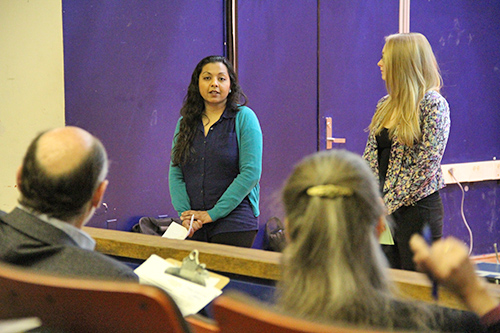SPH Students Create Multi-Faceted Program for South End Community Center.

In just five tightly focused days, a team of SPH students created a far-ranging plan that might help a South End community center improve the health of the people it serves.
The students gave up a week’s reprieve from classes to participate in the Spring Break Challenge, one of the first cross-University programs of its kind. Teams consisting of students from three Boston University schools—the School of Public Health, Sargent College, and the School of Social Work—were challenged to create community-based projects for the Blackstone Community Center (BCC) in the South End.
Working under the name Sage Consultants, Rupal Shah and Sarah Stevens of SPH, Kristie Yeung of SAR, and Erika Gaitan of SSW presented a proposal that blended academic rigor with what judges praised as realistic, readily achievable goals.
For all five of the teams participating in this year’s challenge, the problem was the same: create a model for a sustainable community program at the BCC to fight childhood obesity, spur positive youth development, and increase parental involvement.
The BCC is one of 46 youth and family centers in Boston and provides a range of programs and services for children, teens, and seniors. Since 2013, the center has been a neighborhood site of BU’s Health, Fitness and Wellness Program, which the University sponsored in conjunction with Boston’s continuing efforts to deliver free and low-cost programs to the city’s underserved residents.
For this year’s challenge, the judges added a twist: The team’s projects also needed to involve residents of the nearby housing development, the Ruth Lillian Barkley Apartments.
The Sage Consultants team stressed a “community youth development” framework that would use young people to build bridges to parents and older community residents. Citing prior studies, the team proposed a multi-faceted approach that would incorporate cross-generational event programming, classes, and seminars to build youth skills and deeper partnerships between the center and local organizations such as BU.
Shah said the project was one of the most rewarding she had participated in at SPH, mostly because it required a considerable amount of both collaboration and creativity.
“It made me realize that since everyone was bringing in different expertise and a different skill set, the results were stellar,” said Shah, an epidemiology concentrator. “Everyone was in charge of a different section, and we all needed to be on top of our parts.”
Stevens, a global health concentrator, said she generally likes attacking problems by herself, but found that the format made it impossible. “This project pushed the boundaries at an entirely new level. Given the time frame—we really only had one day to debrief about our key informant interview and focus group discussion process, analyze our data, come up with recommendations, prepare a presentation, and write a report—I just had to trust that my group members would put forth quality work … which they did.”
Harold Cox, associate dean for public health practice, told the contestants that “the struggle that you had was the same one that we had in creating these questions. We knew it was going to be hard. Our responsibility as consultants would be to answer the questions that our clients put out there for us.”
Dean Gail Steketee of SSW, one of the four judges, agreed with Cox, and told the teams that the judges intended to make the challenge live up to its name: “There was no way to cover all of it, so you had to make some difficult decisions.” Steketee was joined on the judging panel by Anne Fidler, assistant dean of public health practice; James Wolff, associate professor of global health; and Stacey Zawacki, director of Sargent Choice Nutrition Center.
BCC Director Keith Houston said all of the presentations gave him the opportunity to consider the possibilities the students’ work revealed.
He further encouraged the students by reminding them that three years ago, the first Spring Break Challenge asked participants to design programs to attract more of the neighborhood’s seniors to the center. “We started with just three seniors, and now there are dozens,”Houston said. “It’s critically important that you understand that you’re a part of this community as well, and that these projects are effective.”